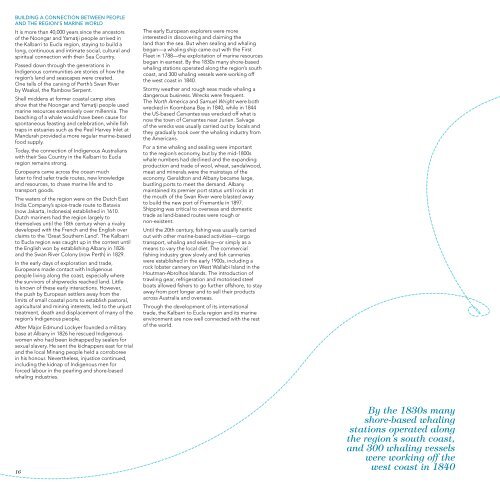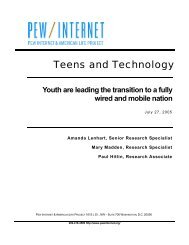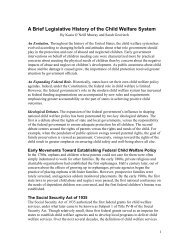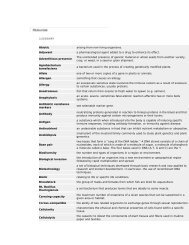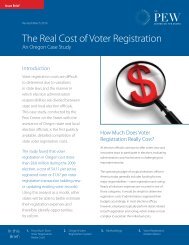Protecting Western Australia's Big Blue Backyard - The Pew ...
Protecting Western Australia's Big Blue Backyard - The Pew ...
Protecting Western Australia's Big Blue Backyard - The Pew ...
You also want an ePaper? Increase the reach of your titles
YUMPU automatically turns print PDFs into web optimized ePapers that Google loves.
BUILDING A CONNECTION BETWEEN PEOPLE<br />
AND THE REGION’S MARINE WORLD<br />
It is more than 40,000 years since the ancestors<br />
of the Noongar and Yamatji people arrived in<br />
the Kalbarri to Eucla region, staying to build a<br />
long, continuous and intimate social, cultural and<br />
spiritual connection with their Sea Country.<br />
Passed down through the generations in<br />
Indigenous communities are stories of how the<br />
region’s land and seascapes were created.<br />
One tells of the carving of Perth’s Swan River<br />
by Waakal, the Rainbow Serpent.<br />
Shell middens at former coastal camp sites<br />
show that the Noongar and Yamatji people used<br />
marine resources extensively over millennia. <strong>The</strong><br />
beaching of a whale would have been cause for<br />
spontaneous feasting and celebration, while fish<br />
traps in estuaries such as the Peel Harvey Inlet at<br />
Mandurah provided a more regular marine-based<br />
food supply.<br />
Today, the connection of Indigenous Australians<br />
with their Sea Country in the Kalbarri to Eucla<br />
region remains strong.<br />
Europeans came across the ocean much<br />
later to find safer trade routes, new knowledge<br />
and resources, to chase marine life and to<br />
transport goods.<br />
<strong>The</strong> waters of the region were on the Dutch East<br />
India Company’s spice-trade route to Batavia<br />
(now Jakarta, Indonesia) established in 1610.<br />
Dutch mariners had the region largely to<br />
themselves until the 18th century when a rivalry<br />
developed with the French and the English over<br />
claims to the ‘Great Southern Land’. <strong>The</strong> Kalbarri<br />
to Eucla region was caught up in the contest until<br />
the English won by establishing Albany in 1826<br />
and the Swan River Colony (now Perth) in 1829.<br />
In the early days of exploration and trade,<br />
Europeans made contact with Indigenous<br />
people living along the coast, especially where<br />
the survivors of shipwrecks reached land. Little<br />
is known of these early interactions. However,<br />
the push by European settlers away from the<br />
limits of small coastal ports to establish pastoral,<br />
agricultural and mining interests, led to the unjust<br />
treatment, death and displacement of many of the<br />
region’s Indigenous people.<br />
After Major Edmund Lockyer founded a military<br />
base at Albany in 1826 he rescued Indigenous<br />
women who had been kidnapped by sealers for<br />
sexual slavery. He sent the kidnappers east for trial<br />
and the local Minang people held a corroboree<br />
in his honour. Nevertheless, injustice continued,<br />
including the kidnap of Indigenous men for<br />
forced labour in the pearling and shore-based<br />
whaling industries.<br />
<strong>The</strong> early European explorers were more<br />
interested in discovering and claiming the<br />
land than the sea. But when sealing and whaling<br />
began—a whaling ship came out with the First<br />
Fleet in 1788—the exploitation of marine resources<br />
began in earnest. By the 1830s many shore-based<br />
whaling stations operated along the region’s south<br />
coast, and 300 whaling vessels were working off<br />
the west coast in 1840.<br />
Stormy weather and rough seas made whaling a<br />
dangerous business. Wrecks were frequent.<br />
<strong>The</strong> North America and Samuel Wright were both<br />
wrecked in Koombana Bay in 1840, while in 1844<br />
the US-based Cervantes was wrecked off what is<br />
now the town of Cervantes near Jurien. Salvage<br />
of the wrecks was usually carried out by locals and<br />
they gradually took over the whaling industry from<br />
the Americans.<br />
For a time whaling and sealing were important<br />
to the region’s economy, but by the mid-1800s<br />
whale numbers had declined and the expanding<br />
production and trade of wool, wheat, sandalwood,<br />
meat and minerals were the mainstays of the<br />
economy. Geraldton and Albany became large,<br />
bustling ports to meet the demand. Albany<br />
maintained its premier port status until rocks at<br />
the mouth of the Swan River were blasted away<br />
to build the new port of Fremantle in 1897.<br />
Shipping was critical to overseas and domestic<br />
trade as land-based routes were rough or<br />
non-existent.<br />
Until the 20th century, fishing was usually carried<br />
out with other marine-based activities—cargo<br />
transport, whaling and sealing—or simply as a<br />
means to vary the local diet. <strong>The</strong> commercial<br />
fishing industry grew slowly and fish canneries<br />
were established in the early 1900s, including a<br />
rock lobster cannery on West Wallabi Island in the<br />
Houtman-Abrolhos Islands. <strong>The</strong> introduction of<br />
trawling gear, refrigeration and motorised steel<br />
boats allowed fishers to go further offshore, to stay<br />
away from port longer and to sell their products<br />
across Australia and overseas.<br />
Through the development of its international<br />
trade, the Kalbarri to Eucla region and its marine<br />
environment are now well connected with the rest<br />
of the world.<br />
16<br />
By the 1830s many<br />
shore-based whaling<br />
stations operated along<br />
the region’s south coast,<br />
and 300 whaling vessels<br />
were working off the<br />
west coast in 1840<br />
Perth’s iconic Cottesloe Beach is part<br />
of <strong>Western</strong> Australia’s marine lifestyle<br />
but is under threat from predicted sea<br />
level rises caused by climate change<br />
© Nico Kenderessy


